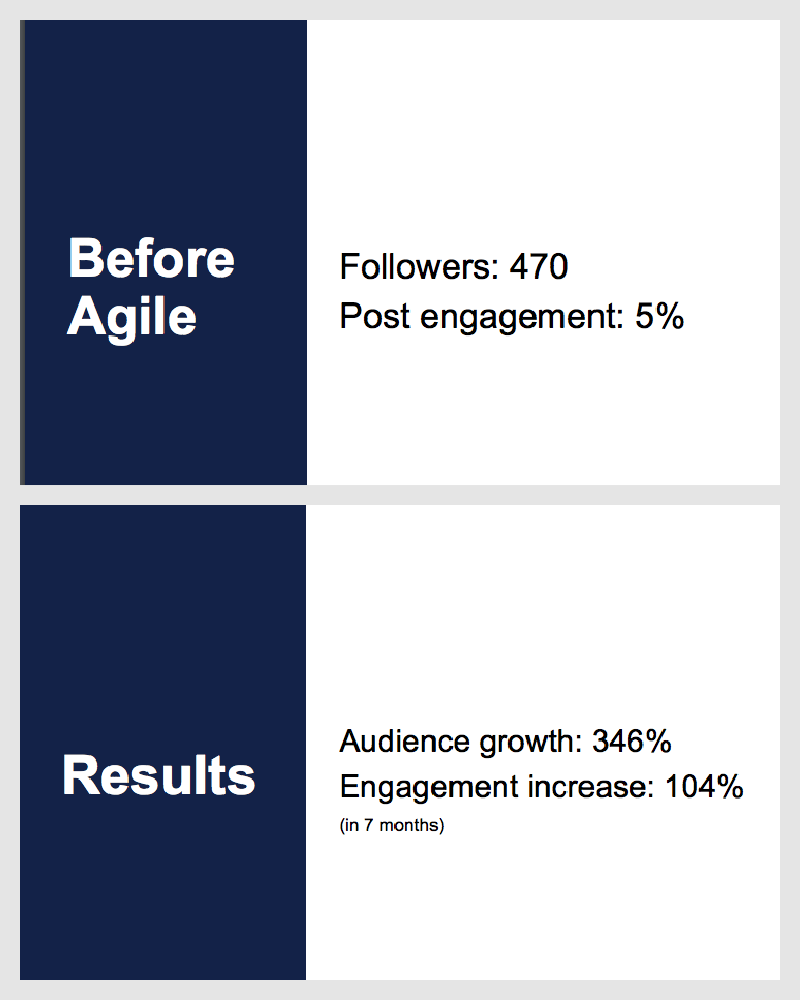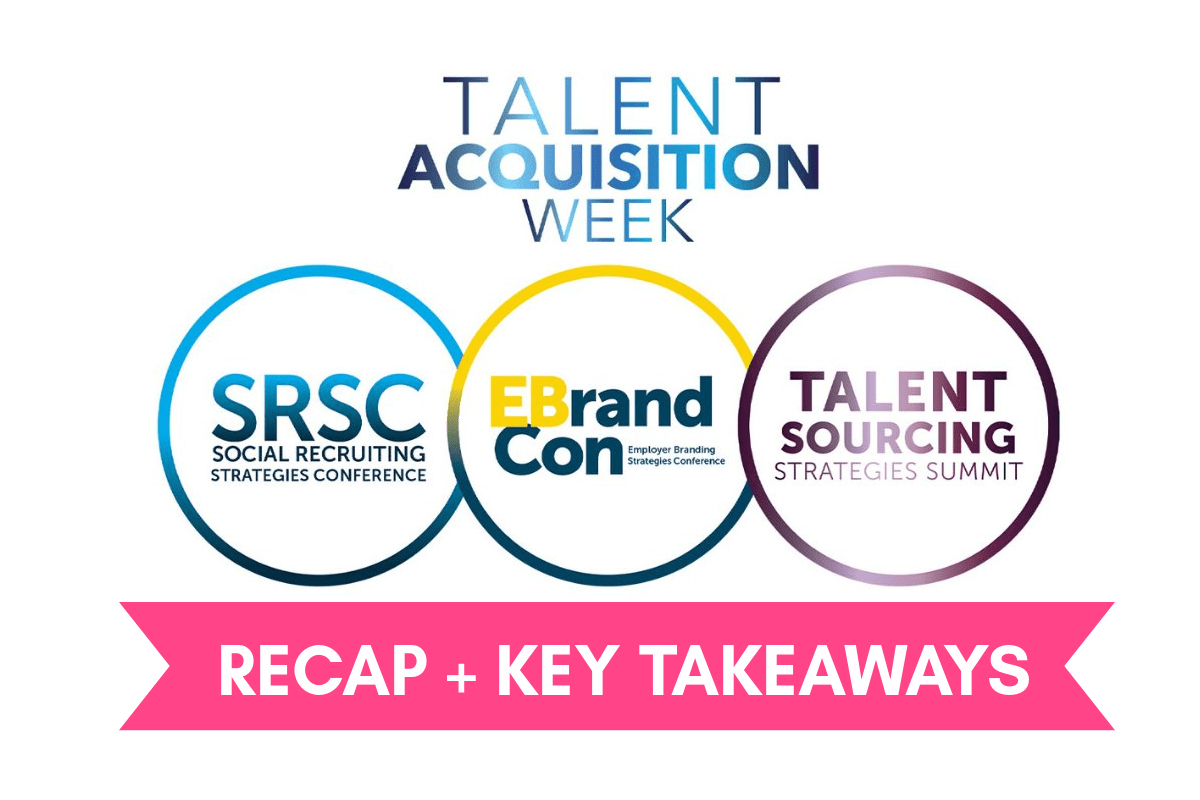TA Week Recap: Next-level TA, DEI, employer branding strategies
This has been a year packed with change. It required us all to revisit our fundamentals … or reinvent ourselves completely.
TA Week — EBrandCon, SRSC, and Talent Sourcing Strategies — virtually brought together industry leaders from around the world for five info-packed days to discuss how practitioners innovated in the face of change, or how they doubled-down on what’s always true to connect and convert candidates.
We were there for all of it — for the TA, DEI, social recruiting, sourcing and employer branding strategies and more. And while we’d love to recap every single valuable session, there was too much learning for that to be possible. So, here’s a recap of (just a few!) of the awesome presentations.
Talent Acquisition
TA State of the Union
Susan LaMotte of exaqueo kicked things off with a “TA State of the Union,” where she highlighted the extreme shifts we’ve seen in the TA landscape and what that means for the employer. The main takeaway: Hiring employees can no longer be considered a transaction.
Candidates have more choice than ever, and employment must now be thought of as a multi-dimensional relationship. Employers need to show empathy and understanding for how candidates and employees feel about each of the four dimensions of the employment experience: the organization, its leaders, the work itself, and co-workers.
According to Susan, the past year has given candidates time to reflect on what it is they want. And, as an employer, it’s more important than ever to show what you offer, so candidates can match accordingly.
Data for Strategic TA Decisions
Talent acquisition leaders from a variety of industries —higher education, gaming, and banking — shared how they each rely on data to tackle their talent acquisition challenges. Led by Andrew Gadomski, Managing Director at ASPEN Analytics, the panelists dove deep into their data gathering methods and metrics, which inform their strategic decision-making and ultimately, their employer brands.
Panelist Tatiyana Cure, Head of Talent Acquisition and Learning and FVP for Bank Leumi, shared that the banking roles her team fills often take 18-24 months to recruit from start to finish. Thus, Bank Leumi’s most important TA metric is retention. Cross-analyzing interview score cards and employee retention timelines provides them with key decision-making data for improving their hiring and onboarding practices.
Likewise, Kimberly Jones, Senior Director of Enterprise Talent Strategy at U.C. Irvine discussed how data helps her team maximize the volume and quality of candidates, and timeliness of hiring across the university and its major health centers. As her organization is a tax-payer funded public university, she shared the importance of data in developing both internal and external hiring practices, and how to communicate the data and decisions to a variety of stakeholders, including a host of unions.
And, Michelle Randall-Berry, Senior Director, Talent Acquisition at gaming giant IGT shared the importance of data for a technology and B2B organization with many various business lines. Data helps IGT develop an employer brand that is applicable across the whole diverse organization. Her most important metric: globally standardized process for hiring. No small feat!
Social Recruiting
Get Agile
Derek Murphy-Johnson, Senior Manager, Talent Attraction at KinderCare Education, and Tracey Parsons of Parsons Strategic Consulting, presented one of the most engaging (and funny!) case studies we’ve ever watched. They shared how together they applied a tech industry stalwart — agile methodology — to KinderCare’s social recruiting strategy. The results paid off, dramatically increasing engagement, audience, and applicant flow. Check out these results!

Employer Brand
Audra Knight, Senior Manager of Employer Branding at Foundation Medicine, was the emcee of Employer Brand day, helping the speakers share their stories and insights. She also helped tie together the employer branding strategies shared throughout the day, engaging us with polls and discussions about EVPs, personas, content creation, employee advocacy and more.
Activating Employer Brand
Allison Kruse is an employer brand team of one, and with help from exaqueo has built and launched Baxter’s global employer brand this year.
She speaks our language: content is critical to activate your brand, whether it “flows like a waterfall or sits like a lake.”
She also presented a model (from exaqueo) that highlights there are two important stakeholders: employees and potential employees. Each has its own hierarchy of needs.
“You can’t have one message externally that isn’t validated and confirmed internally,” Allison said. “You can’t say you’re a great place for parents and have a sucky leave policy… It must align. Content must be reinforced from within to make sense externally.”
Diversity, Equity and Inclusion
Humanizing Diversity
Rocki Howard, Chief Diversity Officer of SmartRecruiters, has a warning:
We have to be willing to get uncomfortable. DEI is uncomfortable.
“Learn to have some courageous conversations. We have to talk about the fact that Racism, bias and inequities exist in our communities and companies. We have to talk about the lack of support and commitment from organizational leaders that hinder progress. We have to talk about the disparities between corporate diversity investment and our talk track.”
Rocki broke down for us the Success Pillars of diversity hiring maturity, which correspond with the candidate experience journey:
- Diversity brand equity
- Strategic sourcing
- Fair hiring practices
- Organizational support
She invited us all to prioritize these pillars through actions in order to truly change our current DEI landscape.
Lived Experience for a Diverse & Inclusive Employer Brand
We were nodding along throughout all of John Graham, Vice President of Global Employer Brand, Diversity & Culture at Shaker Recruitment Marketing’s, presentation. He pointed out some stark stats.
- Senior level women are likely to be the only woman in the room at work.
- Black employees are 30% more likely than white employees to leave a company.
- If there is no change in current promotion, attrition and external hiring rates, it could take about 95 years for Black private sector employees in the U.S. to reach parity in management positions.
However, he broke down how if companies increase representation of team members from underrepresented groups, this doesn’t necessitate inclusion, equity or retention. He says, “Companies can’t out-hire a bad culture.” He shares how Lived Experience is the key to wholly wrapping DEI into an employer brand. By giving voice to underrepresented employees’ lived experience at work, companies will create a culture that they want to invite others to join.
As communicators of team members’ stories of their real experiences in the workplace, we couldn’t agree more.
Employee Stories for Diversity
And, our own Brettany Payne and Anna Lippe, content strategists, project managers and Stories Inc. experts, took the virtual stage. Their session, “How Leading Brands Use Employee Stories to Communicate Their DEI Progress & Strategy” showed how to uncover compelling DEI stories from employees.
Using four of our best practices and tips, they shared with attendees how to communicate your commitment and progress towards creating an inclusive and diverse workplace. Additionally, they delved into how to connect stories to your brand messaging, values and purpose. For all of their tips, they walked through real examples from leading and progressive companies.
Now, if you missed their session, don’t fret. You can watch it on-demand and download their deck!

